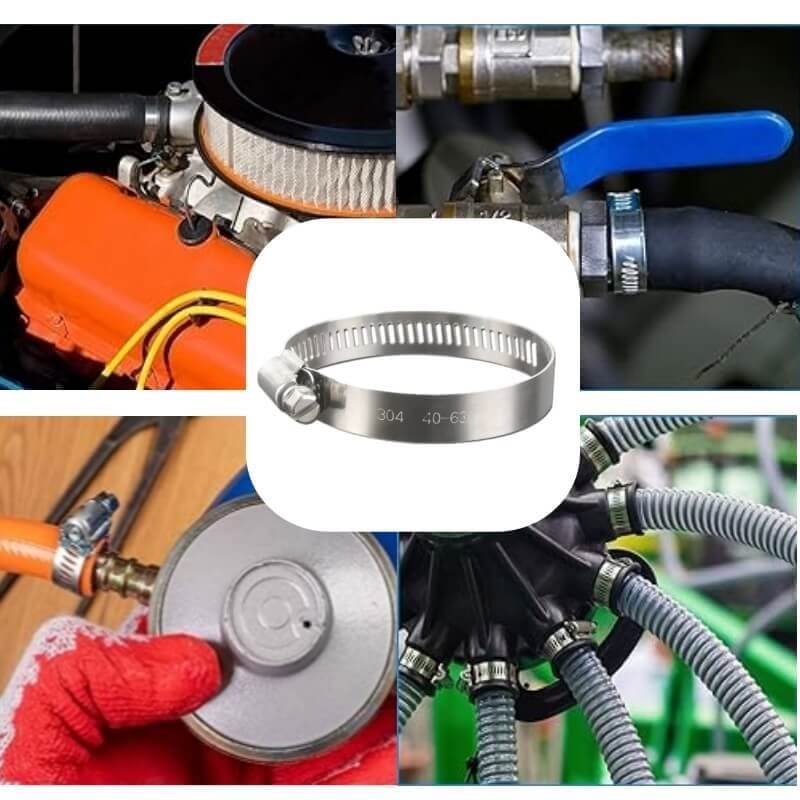Introduction
How Often Should Hose Clamps Be Inspected and Maintained?
Hose clamps are essential components in various industries, including automotive, plumbing, HVAC, and industrial machinery.
They secure hoses to fittings, preventing leaks and ensuring the safe transport of fluids and gases.
However, like all mechanical parts, hose clamps can degrade over time due to corrosion, vibration, temperature fluctuations, and wear.
Regular inspection and maintenance of hose clamps are crucial to prevent system failures, leaks, and potential hazards.
But how often should they be checked? This article explores the recommended inspection frequencies, maintenance best practices,
and signs of wear to ensure optimal performance and longevity.

Why Regular Inspection and Maintenance Are Important
Hose clamps may seem like small, insignificant components, but their failure can lead to:
-
Fluid leaks, causing environmental hazards and equipment damage
-
Loss of pressure, reducing system efficiency
-
Catastrophic failures in critical systems (e.g., coolant leaks in engines)
-
Safety risks, such as fires (in fuel lines) or toxic exposure (in chemical applications)
By implementing a structured inspection and maintenance schedule, businesses and individuals can avoid costly repairs and downtime.
Factors Influencing Inspection Frequency
The ideal inspection interval for hose clamps depends on several factors:
1. Application and Environment
-
Automotive & Marine: Exposed to vibrations, temperature changes, and moisture. Inspect every 3-6 months.
-
Industrial & Manufacturing: High-pressure systems require monthly checks.
-
HVAC & Plumbing: Less extreme conditions may allow for annual inspections.
-
Chemical & Oil Industries: Corrosive environments demand bi-monthly checks.
2. Clamp Material
-
Stainless Steel: Resistant to rust; may need less frequent checks (6-12 months).
-
Galvanized Steel: Prone to corrosion; inspect every 3-6 months.
-
Plastic or Nylon: Degrades under UV exposure; check every 6 months.
3. Operating Conditions
-
High Temperatures: Cause metal fatigue; inspect every 1-3 months.
-
High Vibration (e.g., engines, pumps): Tightening may loosen; check monthly.
-
Exposure to Chemicals/Oils: Accelerates wear; inspect every 2-4 months.
4. Industry Standards & Regulations
Some industries (e.g., aviation, pharmaceuticals) have strict guidelines:
-
OSHA (Occupational Safety and Health Administration): Recommends routine checks in industrial settings.
-
Automotive Manufacturers: Often specify clamp inspections during scheduled maintenance.
Recommended Inspection Intervals
Based on the factors above, here’s a general guideline:
| Application | Inspection Frequency |
|---|---|
| Automotive (daily use) | Every 3-6 months |
| Heavy machinery | Monthly |
| Industrial fluid systems | Every 1-3 months |
| Residential plumbing | Annually |
| Marine applications | Every 3 months |
| Chemical processing | Monthly or bi-monthly |
How to Inspect Hose Clamps
How Often Should Hose Clamps Be Inspected and Maintained?
A proper inspection involves:
1. Visual Check
-
Corrosion: Look for rust or pitting, especially in humid environments.
-
Cracks or Deformation: Check for stress fractures in metal clamps.
-
Loose Clamps: Ensure screws or bands are tight.
2. Tightness Test
-
Use a screwdriver or wrench to verify torque (avoid over-tightening).
-
If a clamp is repeatedly loosening, consider a locking clamp.
3. Hose Condition
-
Inspect the hose for swelling, cracking, or wear near the clamp.
-
A damaged hose can cause clamp failure even if the clamp itself is intact.
4. Leak Detection
-
Look for moisture, drips, or residue around clamped connections.
-
Use a pressure test if necessary.
Maintenance Best Practices
To extend the lifespan of hose clamps:
1. Use the Right Clamp for the Job
-
Worm Gear Clamps: Common but can lose tension over time.
-
T-Bolt Clamps: Better for high-pressure systems.
-
Spring Clamps: Self-tightening, ideal for fluctuating temperatures.
2. Apply Anti-Corrosion Treatments
-
Use stainless steel clamps in wet environments.
-
Apply a light coating of silicone grease to prevent rust.
3. Replace Worn Clamps Proactively
-
If a clamp shows signs of rust, bending, or stripped screws, replace it immediately.
-
Keep spare clamps in inventory for quick replacements.
4. Follow Manufacturer Guidelines
-
Some clamps have specific torque requirements—follow them to avoid under/over-tightening.
Signs It’s Time to Replace a Hose Clamp
Watch for these red flags:
-
Visible rust or corrosion
-
Stripped or damaged screw threads
-
Hose slipping despite tight clamp
-
Cracks or metal fatigue
-
Persistent leaks even after tightening
Conclusion
Hose clamps may be small, but their role in system integrity is critical. Regular inspections—whether monthly, quarterly, or annually—can prevent leaks, equipment damage, and safety hazards.
By understanding the factors that influence wear and following best maintenance practices, you can ensure reliable performance and avoid unexpected failures.
Implementing a structured inspection schedule tailored to your specific application will save time, money, and headaches in the long run.
Don’t wait for a leak to remind you—check those clamps today!
